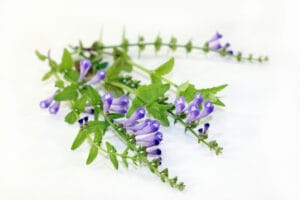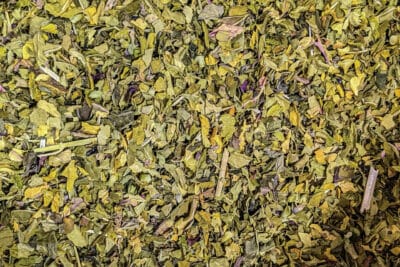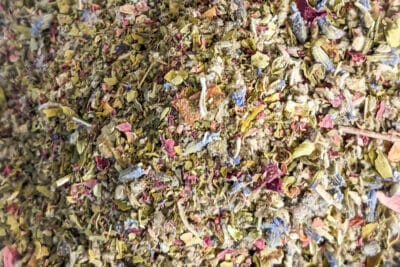Skullcap : Relaxing and Nerve-Soothing Herb
Scutellaria lateriflora
Also referred as:
American scullcap, skullcap, mad dog weed, madweed, and hoodwort.
🍃 Texture when dried
Bright green dried herbs
👅 Taste
Bitter, earthy taste with minty smell
❔ Usage
Smoking herb and sedative (tincture)
💨 Smoke
Moderate smoke
🗜 Harshness
Moderate
⚡ Effects
Sedation, relaxation and improved mood

Table of Contents
Introduction
Skullcap is a perennial herb native to North America, belonging to the mint family. It is known for its beautiful blue-violet flowers and has been traditionally used in herbal teas and smoking blends. Skullcap is cherished for its soothing properties, and it’s commonly enjoyed as a calming beverage, especially before bedtime.
Smokably products with Skullcap :
-
 SkullcapCAD $10.00 – CAD $14.00
SkullcapCAD $10.00 – CAD $14.00 -
 Skull Island▸ Herbal Blend from Skullcap, Mullein, Damiana, Lavender, RoseCAD $12.00 – CAD $18.00
Skull Island▸ Herbal Blend from Skullcap, Mullein, Damiana, Lavender, RoseCAD $12.00 – CAD $18.00
Frequently asked questions
Is it common to smoke Skullcap?
While it’s not as common as using skullcap in teas, some people do smoke skullcap herb as part of herbal smoking blends. These blends often include a mix of different herbs like skullcap, lavender, or mugwort for various purposes. Smokers who prefer natural alternatives to tobacco may choose skullcap for its calming properties and unique flavor.
Is Skullcap smoked on its own or mixed with other herbs?
Skullcap can be smoked on its own, but it’s more commonly combined with other herbs in herbal smoking blends. Mixing skullcap with other herbs like lavender, mugwort, or chamomile allows for a variety of flavors and complementary effects. This also creates a more balanced and enjoyable smoking experience for those seeking natural, tobacco-free alternatives.
Can Skullcap help you quit smoking?
While skullcap may not directly help you quit smoking, it can be used as part of a herbal smoking blend to replace tobacco. By choosing a tobacco-free blend featuring skullcap and other herbs, you are avoiding harmful chemicals often found in cigarettes. It’s essential to remember that quitting smoking requires personal commitment and may involve additional support tools, such as nicotine replacement therapy, behavioral counseling, or medication. Using a herbal blend with skullcap is just one option to consider in your journey to quit smoking.
Why do people enjoy Skullcap ?
People enjoy Skullcap for a variety of reasons.
- Soothing properties: Skullcap is known for its calming effects, making it a popular choice for stress relief and relaxation.
- Sleep support: It’s often used as a bedtime tea to help promote a restful night’s sleep.
- Tobacco alternative: As part of herbal smoking blends, skullcap offers a natural option for people looking to avoid tobacco and its associated chemicals.
- Flavor: The unique taste of skullcap is enjoyed by many when blended with other herbs, providing a pleasant smoking or tea-drinking experience.
- Natural origin: As a native North American herb belonging to the mint family, skullcap’s organic, botanical nature appeals to those interested in herbalism and traditional remedies.
NB. Anecdotal or historical claims should not be construed as health claims. Always consult a health specialist prior to oral consumption of any herb. Consumption of any herbs might have side effects.
How do you make a tea out of Skullcap ?
To make a herbal tea out of Skullcap, you can follow these simple steps:
- Measure: Use about 1-2 teaspoons of dried skullcap herb per 8 ounces of water. You can adjust the amount based on your personal taste preference.
- Heat water: Bring the water to a boil, then remove it from the heat source.
- Steep: Add the dried skullcap herb to a teapot or infuser, and pour the hot water over the herb. Cover and let the skullcap steep for 10-15 minutes.
- Strain: If using a teapot, pour the tea into a cup through a fine mesh strainer, or remove the infuser.
- Optional: Sweeten the tea with honey, agave, or your preferred sweetener, and add a squeeze of lemon or a dash of cinnamon for additional flavor.
Mullein tea is known for its mild, earthy flavor with subtle hints of sweetness. It is a popular form of consumption for this herb, often enjoyed for its soothing properties and calming effects. Some people also believe that the tea supports respiratory comfort, although specific health claims cannot be made. The warm, gentle aroma and taste make mullein tea a comforting beverage, especially during cool nights or when seeking a moment of relaxation.
What does Skullcap look like?
Skullcap is a small, perennial herb that typically grows to a height of 1-3 feet. It has slender, branched stems and bears opposite pairs of oval, toothed leaves with a slightly pointed tip. These leaves often have a green or grayish-green hue, and their texture is somewhat rough or hairy.
The most distinctive feature of skullcap is its beautiful flowers. These tubular, two-lipped flowers bloom in clusters and are usually blue-violet in color, though they can occasionally be pink or white. The flowers appear on small spikes that rise from the leaf axils, typically between early summer and mid-autumn.
The overall appearance of skullcap is reminiscent of other plants from the mint family, with its square-shaped stem and opposing pairs of leaves, but its flowers are unique and easily recognizable.
How has Skullcap been used historically?
Historically, skullcap has been used across various cultures for its medicinal properties and as a traditional remedy. Some of its historical uses include:
1. Native American use: Native American tribes, such as the Cherokee, used skullcap to treat a variety of ailments including anxiety, insomnia, and inflammation. They also used it for women’s reproductive health, fever reduction, and relieving nervous tension.
2. Traditional Chinese Medicine: A related species, Chinese skullcap (Scutellaria baicalensis), has been utilized in Traditional Chinese Medicine for centuries. It was commonly used to treat conditions like fever, colds, and gastrointestinal issues. Although different from the North American skullcap, it shares some similar properties.
3. 19th-century herbalism: Skullcap gained popularity in the 19th century as a treatment for nervous disorders, hysteria, and sleep problems. It was often prescribed by early North American herbalists, and its use continued well into the 20th century.
4. Nerve tonic: Skullcap was historically known for its nerve-calming properties and was commonly used as a mild nerve tonic to alleviate stress, anxiety, and restlessness.
It’s important to note that while skullcap has a long history of traditional use, modern scientific research on its potential benefits is limited and health claims cannot be made. However, many people continue to appreciate skullcap for its calming properties, turning to it in the form of herbal teas or as part of smoking blends.



